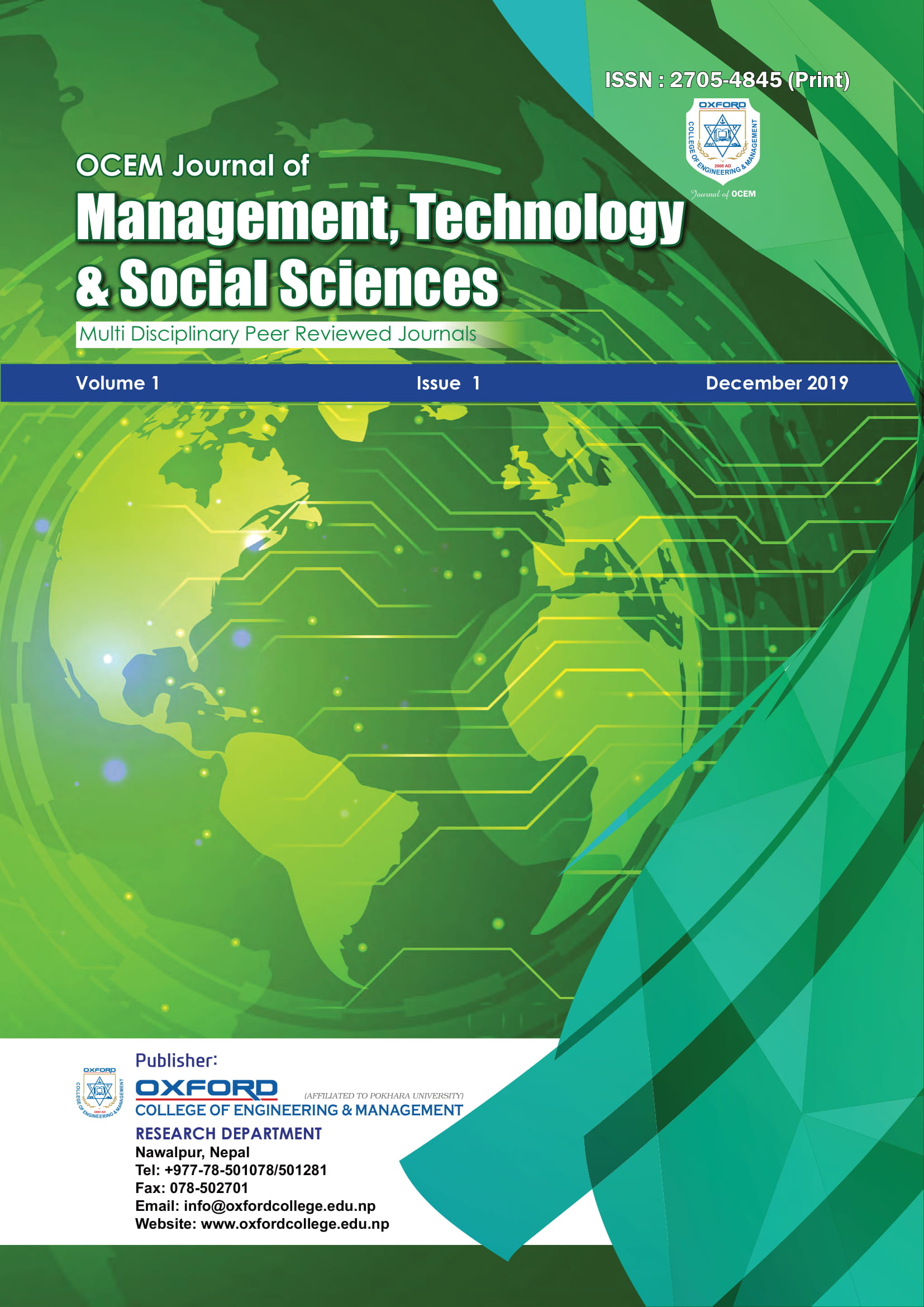The Consequences of Mother International Migration To The Left Behind Girls Under 16 For Their Education, Health & Psycho-Social Development in Chitwan District
Abstract
The primary objective of this study was to examine the consequences of Mother International Migration
(MIM) to the Left Behind Girls under the age of 16 on their Education, Health and Psychosocial
Development in Nepal. A mixed methods approach was used where the survey study and qualitative
interview were used as data collection methods. A five-point Likert scale survey questionnaire and the
Semi-structured Interview were used as research instruments to collect data. The consent form was sent
to immediate parents and the left behind girls for their acceptance to take part in this study. In the first
stage, twenty different schools were selected randomly and later purposive sampling method was used
to select the interviewees. Two hundred and fifty questionnaires were dispatched but two hundred and
thirty-seven survey questionnaires were returned by the returnees which was more than 94.8 % response
rate. Approximately, 45% of the sampled girls were under the age of 12 and 55% of them were between
the age of 12 to 16 in this study. The results show that there was positive relationship between the MIM
and feeling of loneliness, poor health suggestion, poor health condition, negative neighbour’s attitudes,
problem of relationship, and unsupportive house environment (p < 0.05). Again, there is significant
negative association between MIM and social attachment, use of social media and outdoor activities,
better health condition, positive psychosocial feeling, family support and availability of desired food
(p < 0.05). About 80% interviewees realized that their overall development of education, health and
psychosociology have been affected after their MIM. Approximately, 60% interviewees argued that the
development of the education health and psychosocial development were negatively affected by their
MIM. The qualitative results supported the quantitative results to foreground the phenomenon and to get
additional information on something that wasn’t expected on the impact of MIM to the LBGS
Recent increases in MIM to European, Arabic and other countries have invited an upwelling of interest
in how the absence of mothers affect the left-behind girls in Nepal. This study has supported the previous
findings on (MIM) that the LBGs had been negatively affected by the MIM for their education, health &
psychological development. The implication of this study is to aware the policy makers and governmental
administrators about the positive and negative consequences MIM on LBGs for their education, health
and psychosocial development. The main contribution of this study is to add new knowledge on the
consequences of MIM to the LBGs in the archive of foreign employment in the Nepalese context.
Keywords:
Mother international migration, left behind girls, education, health and psychosocial development, respondents, significant relationshipDownloads
References
Adhikari, B. (2018). The negative impacts of MIM to the left behind girls to the left behind girls under 16 years old on education, health and psychosocial development in Chitwan District. Retrieved from https://www.researchgate.net/search.
Adhikari, J. (2006). Nepali women and foreign labour migration (1st Ed.). Kathmandu: UNIFEM.
Agbola, F., & Acupan, A. (2010). An empirical analysis of international labour migration in the Philippines. Economic Systems, 34(4), 386-396.OCEM Journal of Management, Technology & Social Sciences
Antman, F. (2012). Gender, educational attainment, and the impact of parental migration on girls left behind. Journal of Population Economics, 25(4), 1187-1214.
Bank, W. (2007). The International Migration of Women. Washington: World Bank.
Basnet, A. (2013). Impact of Increased Migration Opportunity on Human Capital Accumulation of Young International Migrants: A Case of Nepal. Retrieved from https://www.eur.nl/
Battistella, G., & Conaco, M. (1998). The Impact of Labour Migration on the Children Left Behind: A Study of Elementary School Children in the Philippines. Journal of Social Issues in Southeast Asia, 13(2), 220-241.
Bhadra, G. (2007). Twins in the shadow of a dead baby. Infant Observation, 10(2), 195-202. Botezat, A., & Pfeiffer, F. (2014). The Impact of Parents Migration on the Well-Being of Girls Left Behind Initial Evidence from Romania. SSRN Electronic Journal. http://dx.doi.org/10.2139.
Bouchoucha, I. (2013). The impact of parental migration on children left behind: The case of Tunisia.
Qscience Proceedings, 2013(1), 14. doi: 10.5339/qproc.2013.fmd.19
Cebotari, V., Siegel, M., & Mazzucato, V. (2016). Migration and the education of girls who stay behind in Moldova and Georgia. International Journal of Educational Development, 51, 96-107.
Chandra, B. (2007). International Labour Migration of Nepalese Women: Impact of their Remittances on Poverty Reduction. Retrieved from https://www.econstor.eu/bitstream/10419/17.
Cohen, L., Manion, L., & Morrison, K. (2011). Research methods in education. London, Routledge Publication.
Cohen, R. (1996). Theories of migration. Cheltenham, UK: E. Elgar.
Cortes, P. (2015). The Feminization of International Migration and its Effects on the Left Behind children: Evidence from the Philippines. World Development, 65, 62-78.
Dhar, R. (2012). Women and International Migration: A Cross-cultural Analysis. Social Change, 42(1), 93102.
Gao, Y., Li, L., Chan, E., Lau, J., & Griffiths, S. (2013). Parental Migration, Self-Efficacy and Cigarette Smoking among Rural Adolescents in South China. Plos ONE, 8(3), e57569. doi:
10.1371/journal.pone.0057569.
Giannelli, G., & Mangiavacchi, L. (2010). Girls Schooling and Parental Migration: Empirical Evidence on the ‘Left-behind’ Generation in Albania. LABOUR, 24, 76-92.
Gibson, J., McKenzie, D., & Stillman, S. (2011). The Impacts of International Migration on Remaining Household Members: Omnibus Results from a Migration Lottery Program. Review of Economics and Statistics, 93(4), 1297-1318. doi: 10.1162/rest_a_00129
Gunduz, T., Karbeyaz, K., & Ayranci, U. (2011). Evaluation of the Adjudicated Incest Cases in Turkey: Difficulties in Notification of Incestuous Relationships. Journal of Forensic Sciences, 56(2), 438-443.
Guo, Q., Sun, W., & Wang, Y. (2016). Effect of Parental Migration on Women Health in Rural China. Review of Development Economics. http://dx.doi.org/10.1111/rode.12289
Hoang, L., Lam, T., Yeoh, B., & Graham, E. (2014). Transnational migration, changing care arrangements and left-behind girls’ responses in South-east Asia. Girls Geographies, 13(3), 263277.
Hujo, K., & Piper, N. (2007). South South Migration: Challenges for development and social policy. Development, 50(4), 19-25.OCEM Journal of Management, Technology & Social Sciences
Hysing, M., Petrie, K., Bøe, T., & Sivertsen, B. (2017). Parental work absenteeism is associated with increased symptom complaints and school absence in adolescent children. BMC Public Health,17(1). doi: 10.1186/s12889-017-4368-7
Jampaklay, A., Richter, K., Tangchonlatip, K., & Nanthamongkolchai, S. (2018). The impact of parental absence on early childhood development in the context of Thailand. Asian and Pacific Migration Journal, 27(2), 209-230.
Jensen, B., Giorguli Saucedo, S., & Hernández Padilla, E. (2018). International Migration and the Academic Performance of Mexican Adolescents. International Migration Review, 52(2), 559-596
Lahaie, C., Hayes, J., Piper, T., & Heymann, J. (2009). Work and family divided across borders: the impact of parental migration on Mexican girls in transnational families. Community. Work & Family, 12(3), 299312.
Lu, Y. (2012). Education of Girls Left Behind in Rural China. Journal of Marriage and Family, 74(2), 328341.
Lu, Y. (2015). Internal migration, international migration, and physical growth of left-behind children: A study of two settings. Health & Place, 36, 118-126
Man, Y., Mengmeng, L., Lezhi, L., Ting, M., & Jingping, Z. (2017). The psychological problems and related influential factors of left-behind adolescents (LBA) in Hunan, China: a cross sectional study. International Journal for Equity in Health, 16(1). doi: 10.1186/s12939-017-0639-2
Mazhuvanchery, S. (2015). 6. International Labour Organization (ILO). Yearbook of International Environmental Law, 26, 583-587.
Meyerhoefer, C., & Chen, C. (2010). The effect of parental labour migration on children’s educational progress in rural china. Review of Economics of the Household, 9(3), 379-396.
Peng, Y., & Wong, O. (2015). Who Takes Care of My Left-Behind Girls? Migrant Mothers and Caregivers in Transnational Child Care. Journal of Family Issues, 37(14), 2021-2044.
Pescaru, M. (2015). Consequences of Parents’ Migration on Children Rearing and Education. Procedia - Social and Behavioural Sciences, 180, 674-681.
Resurreccion, B. (2005). International Workshop on the Impacts of Migration on ‘Left-Behind’ in Asia. Gender, Technology and Development, 9(3), 437-440.
Rossi, A. (2009). The Impact of Migration on Children Left Behind in Developing Countries: Outcomes Analysis and Data Requirements. SSRN Electronic Journal. doi: 10.2139/ssrn.2490380
Sijapati, B, (2015). Women Labour Migration from Asia to the Pacific; Opportunity and Challenges; International Organization for Migration, 12, 1-16.
Tong, Y., Luo, W., & Piotrowski, M. (2015). The Association between Parental Migration and Childhood Illness in Rural China. European Journal of Population, 31(5), 561-586.
Torgler, B., & Valev, N. (2016). Women and Illegal Activities: Gender Differences and Women’s Willingness to Comply Over Time. SSRN Electronic Journal. http://dx.doi.org/10.2139/ssrn.
Urias, D. (2012). The immigration & education nexus (1st ed.). Rotterdam: Sense Publishers.
Vandevivere, E., Braet, C., Bosmans, G., Mueller, S., & De Raedt, R. (2014). Attachment and Children’s Biased Attentional Processing: Evidence for the Exclusion of Attachment-Related Information. Plos ONE, 9(7), e103476. doi: 10.1371/journal.pone.0103476OCEM Journal of Management, Technology & Social Sciences 20
Viet Nguyen, C. (2016). Does parental migration really benefit left-behind girls? Comparative evidence from Ethiopia, India, Peru and Vietnam. Social Science & Medicine, 153, 230-239.
Wise, P., & Blair, M. (2007). The UNICEF Report on Child Well-Being. Ambulatory Pediatrics, 7(4), 265-266.
Wickramage, K., Siriwardhana, C., Vidanapathirana, P., Weerawarna, S., Jayasekara, B., & Pannala, G. et al. (2015). Risk of mental health and nutritional problems for left-behind children of international labour migrants. BMC Psychiatry, 15(1). doi: 10.1186/s12888-015-0412-2
Yeoh, B., & Lam, T. (2016). Immigration and Its (Dis) Contents. American Behavioural Scientist, 60(5-6), 637-658.
Zhao, C., Wang, F., Li, L., Zhou, X., & Hesketh, T. (2017). Long-term impacts of parental migration on Chinese children’s psychosocial well-being: mitigating and exacerbating factors. Social Psychiatry and Psychiatric Epidemiology, 52(6), 669-675.
Downloads
Published
Versions
- 2019-12-01 (2)
- 2024-11-01 (1)
How to Cite
Issue
Section
License
Copyright (c) 2024 The OCEM Journal of Management, Technology, and Social Sciences

This work is licensed under a Creative Commons Attribution 4.0 International License.
© 2024 by The OCEM Journal of Management, Technology and Social Sciences is licensed under CC BY-NC 4.0






